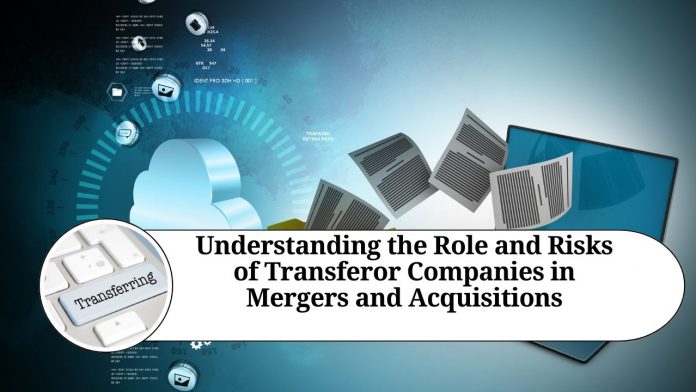INTRODUCTION
When a company undergoes a merger or acquisition, there are two main parties involved: the acquiring company and the transferor company. The transferor company is the entity that is transferring its assets, liabilities, and operations to the acquiring company.
The transferor company is typically the one that is being acquired, but it can also refer to a subsidiary or division of a larger company that is being spun off or sold. In either case, the transferor company is essentially giving up control of its business to another entity.
The transfer of ownership from the transferor company to the acquiring company typically takes place through a legal process known as a merger or acquisition. During this process, the acquiring company will typically pay a premium to acquire the transferor company’s assets and assume its liabilities.
One of the main reasons why companies undergo mergers and acquisitions is to achieve economies of scale and improve their competitive position in the market. By acquiring the transferor company’s assets, the acquiring company can expand its operations and gain access to new markets, customers, and technologies.
However, mergers and acquisitions can also be a complex and risky process, as there are many factors that can affect the success of the transaction. For example, the transferor company may have hidden liabilities or legal issues that the acquiring company is not aware of, which can lead to costly legal battles down the line.
Another risk associated with mergers and acquisitions is the potential for cultural clashes between the two companies. If the acquiring company fails to integrate the transferor company’s employees and operations effectively, it can lead to decreased productivity and morale, and ultimately harm the overall success of the transaction.
The transferor company plays a crucial role in the mergers and acquisitions process, as it is the entity that is being acquired or sold. Before any transaction can take place, the transferor company must agree to the terms of the deal and ensure that all legal requirements are met.
In some cases, the transferor company may also need to seek approval from its shareholders, regulators, or other stakeholders before the transaction can proceed. This can be a complex process, as it requires careful communication and negotiation with all parties involved.
During the mergers and acquisitions process, the transferor company will typically work closely with the acquiring company to ensure a smooth transition of ownership. This may involve transferring ownership of physical assets, such as real estate or equipment, as well as intangible assets, such as intellectual property or customer relationships.
The transferor company may also be responsible for resolving any outstanding legal or financial issues, such as outstanding debt or legal disputes. This can be a time-consuming process, but it is important to ensure that the acquiring company is not taking on any hidden liabilities or risks.
Ultimately, the success of a merger or acquisition depends on a variety of factors, including the compatibility of the two companies, the quality of due diligence, and the ability to execute the transaction effectively. While the transferor company is just one party in this complex process, it plays a crucial role in ensuring the success of the transaction and protecting the interests of its shareholders and other stakeholders.
Conclusion
In conclusion, the transferor company is a key player in the mergers and acquisitions process, as it is the entity that is being acquired or sold. This process can be complex and risky, but if executed properly, it can provide many benefits to both the acquiring company and the transferor company.
Other Related Blogs: Section 144B Income Tax Act
Frequently Asked Questions (FAQs)
Q: What is a transferor company? A: A transferor company is a company that is being acquired, sold, or spun off in a merger or acquisition. It is the entity that is transferring its assets, liabilities, and operations to another entity.
Q: What is the role of a transferor company in a merger or acquisition? A: The transferor company plays a crucial role in the mergers and acquisitions process, as it is the entity that is being acquired or sold. It must agree to the terms of the deal and ensure that all legal requirements are met. It is also responsible for transferring ownership of assets and resolving any outstanding legal or financial issues.
Q: What are the risks associated with mergers and acquisitions for the transferor company? A: There are many risks associated with mergers and acquisitions, including hidden liabilities or legal issues, cultural clashes between the two companies, and the potential for decreased productivity and morale if the integration process is not handled effectively.
Q: How can a transferor company mitigate the risks associated with mergers and acquisitions? A: To mitigate the risks associated with mergers and acquisitions, the transferor company should conduct a thorough due diligence process to identify any potential issues or risks. It should also work closely with the acquiring company to ensure a smooth transition of ownership and integration of operations.
Q: Can a transferor company sell only a part of its business in a merger or acquisition? A: Yes, a transferor company can sell only a part of its business in a merger or acquisition. This is known as a partial acquisition or divestiture, and it can be a strategic way to focus on core business areas and improve overall efficiency.
Q: What happens to the employees of the transferor company during a merger or acquisition? A: The fate of the employees of the transferor company during a merger or acquisition depends on the specific terms of the deal. In some cases, employees may be retained by the acquiring company, while in other cases, they may be laid off or offered a severance package. The transferor company should communicate clearly with employees throughout the process to minimize uncertainty and disruption.




















